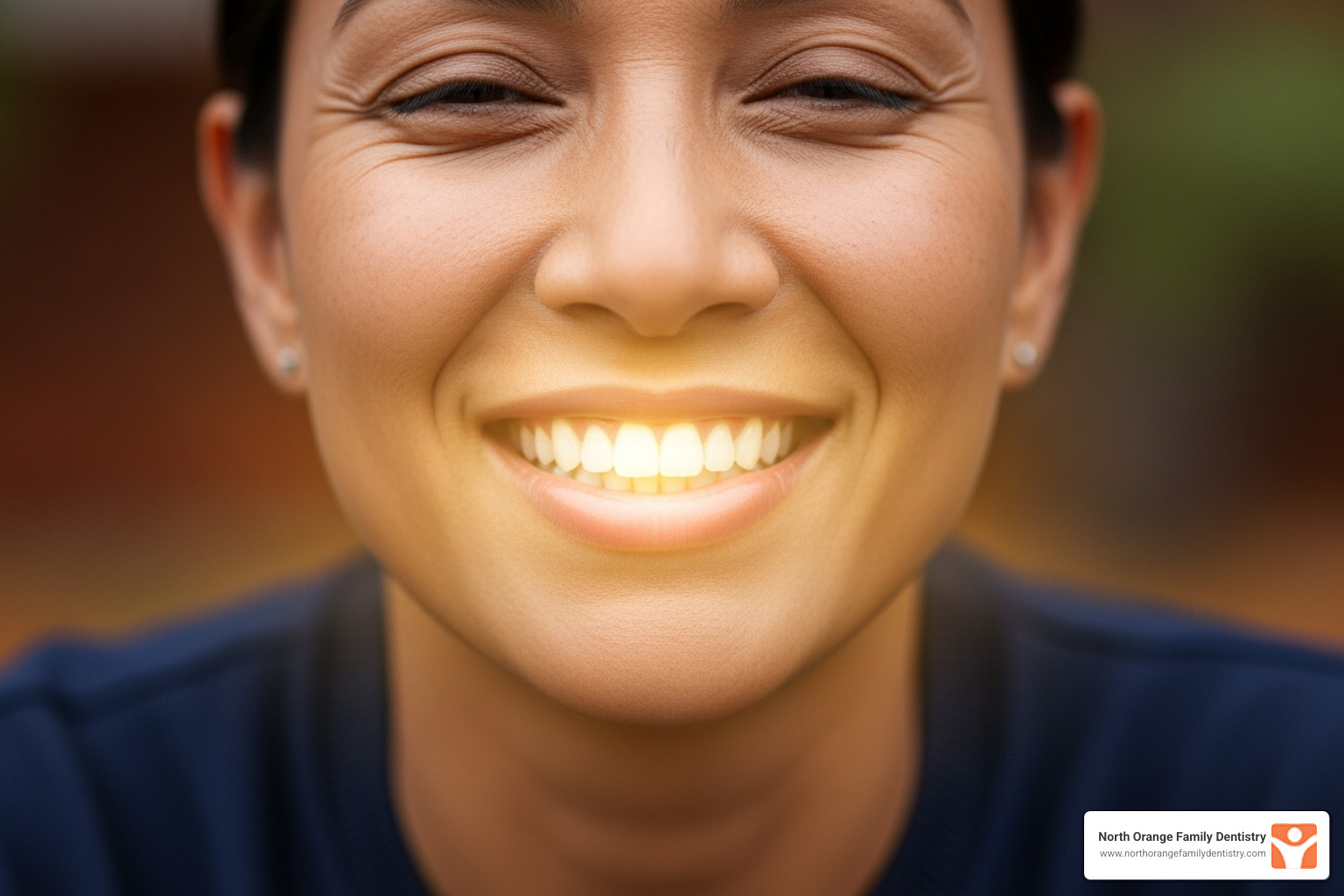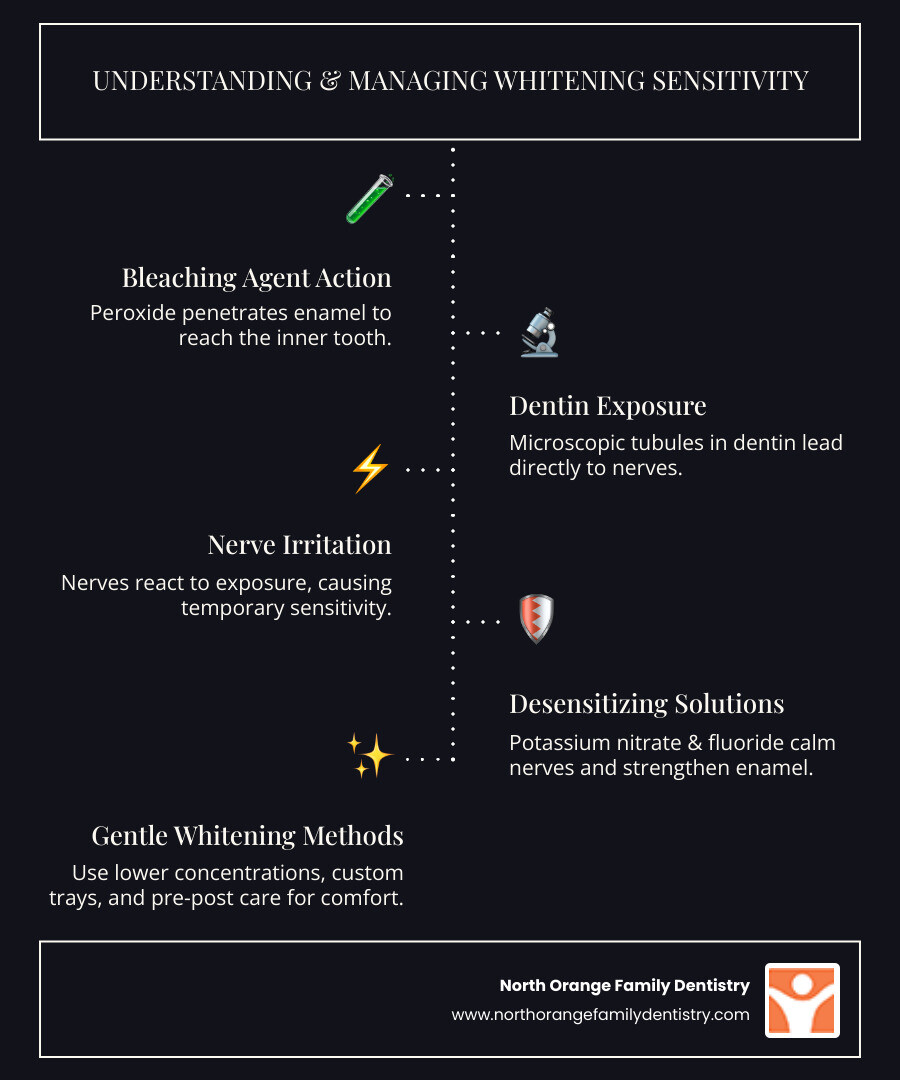
Gentle Glow: Discover the Best Whitening Solutions for Sensitive Smiles
Achieve a gentle glow! Find safe and effective whitening for sensitive teeth solutions, plus tips to prevent discomfort.


Your Guide to a Brighter, Comfortable Smile
A bright, white smile is a goal for many, but for patients with sensitive teeth the thought of whitening can be daunting. At North Orange Family Dentistry in Lewis Center, Ohio, we believe you should never have to choose between a radiant smile and lasting comfort. Modern techniques, thoughtful product selection, and expert guidance make whitening for sensitive teeth easier, safer, and more predictable than ever.
Dr. Kyle Bogan and our five-star team see whitening patients every day—from teens preparing for senior photos to adults who simply want a confidence boost for work or social events. If you have ever felt that sharp “zing” of sensitivity, this guide is for you. We’ll explore why whitening causes discomfort, compare at-home and professional options, outline practical steps to keep sensitivity at bay, and show you how our personalized approach (including our in-house Dental Wellness Plan for patients without insurance) can help you achieve the brilliant smile you deserve.

What Causes Sensitivity During Teeth Whitening?
Most whitening products rely on hydrogen peroxide or carbamide peroxide to break down deep-set stains. These molecules penetrate your outer enamel and reach the dentin—the softer yellow layer that holds thousands of microscopic tubules leading to the nerve. When peroxide travels through these tubules, it can temporarily inflame the nerve and trigger discomfort. According to the research summary in “Tooth Whitening: What We Now Know”, as many as two-thirds of whitening patients report at least mild sensitivity.
Factors that increase the risk include:
- Naturally thin enamel – less protection between the whitening gel and the nerve.
- Gum recession – exposed root surfaces have no enamel at all.
- Existing dental issues – cavities, leaking fillings, or cracks create a direct pathway to the pulp.
- High peroxide concentration or overuse – stronger gels work fast but can over-stimulate the nerve.
Before any whitening treatment, Dr. Bogan performs a thorough examination to check for these conditions, address decay, and determine whether a gentle approach or additional protective steps are needed.
Gentle At-Home Whitening for Sensitive Teeth
At-home kits are convenient, affordable, and can work beautifully—if you pick the right formula and take it slow. Below is a quick comparison of the most common options we recommend to sensitivity-prone patients.
| At-Home Method | Speed of Results | Comfort Level | Typical Cost |
|---|---|---|---|
| “Sensitive” Whitening Strips (5.25% peroxide) | 10–14 days | Good | Low |
| Low-Peroxide Brush-On Gels | 7–10 days | Good | Low–Moderate |
| Custom Trays Dispensed by Dentist (10% carbamide peroxide) | 5–7 days | Excellent (with desensitizer) | Moderate |
| Peroxide-Free Pens (papain & essential oils) | 2–3 weeks | Excellent | Low |
| Sensitive Whitening Toothpaste (potassium nitrate + fluoride) | Ongoing, gradual | Excellent | Minimal |
Tips for success at home
- Choose lower peroxide concentrations or peroxide-free alternatives when possible.
- Look for desensitizing ingredients such as potassium nitrate, fluoride, or nano-hydroxyapatite.
- Follow the manufacturer’s wear-time exactly—even an extra 10 minutes can make a big difference.
- Use a soft-bristled brush and lukewarm water during the whitening period.
- Pause every other day if you notice a “zing.” Spacing treatments allows the nerve to calm down.
Curious which product fits your lifestyle? Our resource on What Teeth Whitening Options Are Best dives deeper.
Professional Whitening for Sensitive Teeth

In our Lewis Center office we offer two sensitivity-friendly professional options:
- In-office, light-accelerated whitening – A protective gel is painted onto the gums, then a 15%–25% hydrogen peroxide gel is applied in short cycles. Because we control every variable—gel thickness, temperature, protection time—patients often experience less irritation than at home. Most reach their desired shade in about an hour.
- Custom take-home trays with professional-strength gel – Molded precisely to your teeth, these trays hold a lower concentration carbamide peroxide close to the enamel while keeping gel off the gums. We add a syringe of potassium-nitrate desensitizer so you can whiten nightly with minimal “zing.”
The biggest benefit of professional care is flexibility: if discomfort occurs, we can pause, apply a fluoride varnish, or switch formulations without derailing the entire process. Learn more about our approach in Teeth Whitening at Dental Office or schedule a cosmetic consultation through our Cosmetic Dentist Lewis Center page.
How to Prevent and Manage Whitening Discomfort
Whitening-related sensitivity is usually temporary, but these simple habits keep discomfort to a minimum:
- Prime your teeth – Brush with a desensitizing toothpaste for two weeks before whitening.
- Use a soft-bristled brush and gentle strokes – Aggressive brushing wears enamel and exposes dentin.
- Take short breaks – One-day rests between bleaching sessions allow nerve fibers to calm.
- Avoid acidic foods and drinks – Citrus, soda, and wine can exacerbate post-whitening tingles.
- Sip through a straw – If you can’t give up iced coffee, let the straw carry it past the front teeth.
- Rinse with lukewarm water – Extreme temperatures can trigger a painful reaction during treatment.
For additional ideas, visit More on managing sensitivity.
Achieve Your Whitening Goals with Professional Guidance
When to Consult Your Dentist Before Whitening
A short visit with Dr. Bogan helps us:
- Diagnose the true cause of your sensitivity (cavity, cracked filling, gum recession).
- Evaluate enamel thickness and gum health to choose the safest peroxide level.
- Create custom trays or recommend a specific over-the-counter kit so you don’t waste time or money.
- Discuss other smile-boosting options—Invisalign, bonding, veneers, or a single dental implant (our endosteal implants average about $4,500 per tooth)—that may complement whitening.
Our team also offers same-day emergency appointments when unexpected dental pain strikes and advanced laser therapy for TMJ pain, canker sore healing, and periodontal treatment. These services, combined with digital impressions, intra-oral cameras, and 3-D imaging, make North Orange Family Dentistry a one-stop, state-of-the-art practice for families across Lewis Center, Delaware, and the greater Columbus area.
Risks, Rewards, and Your Path to a Radiant Smile
Like any dental procedure, whitening has pros and cons:
- Rewards – Boosted confidence, more youthful appearance, motivation to maintain excellent oral hygiene.
- Risks – Temporary sensitivity or gum irritation if instructions aren’t followed; results can fade over time due to diet or habits like smoking.
Our promise is to maximize the rewards while minimizing the risks through customized plans, careful monitoring, and education. For patients without dental insurance, our Dental Wellness Plan bundles two cleanings, needed X-rays, exams, and exclusive discounts—so you can budget for routine care and cosmetic upgrades such as whitening without surprises.
Ready to explore gentle whitening in a friendly, judgment-free environment? Visit our website to request an appointment and start your journey toward a brighter, comfortable smile today.
Your Guide to a Brighter, Comfortable Smile
A bright, white smile is a goal for many, but for patients with sensitive teeth the thought of whitening can be daunting. At North Orange Family Dentistry in Lewis Center, Ohio, we believe you should never have to choose between a radiant smile and lasting comfort. Modern techniques, thoughtful product selection, and expert guidance make whitening for sensitive teeth easier, safer, and more predictable than ever.
Dr. Kyle Bogan and our five-star team see whitening patients every day—from teens preparing for senior photos to adults who simply want a confidence boost for work or social events. If you have ever felt that sharp “zing” of sensitivity, this guide is for you. We’ll explore why whitening causes discomfort, compare at-home and professional options, outline practical steps to keep sensitivity at bay, and show you how our personalized approach (including our in-house Dental Wellness Plan for patients without insurance) can help you achieve the brilliant smile you deserve.

What Causes Sensitivity During Teeth Whitening?
Most whitening products rely on hydrogen peroxide or carbamide peroxide to break down deep-set stains. These molecules penetrate your outer enamel and reach the dentin—the softer yellow layer that holds thousands of microscopic tubules leading to the nerve. When peroxide travels through these tubules, it can temporarily inflame the nerve and trigger discomfort. According to the research summary in “Tooth Whitening: What We Now Know”, as many as two-thirds of whitening patients report at least mild sensitivity.
Factors that increase the risk include:
- Naturally thin enamel – less protection between the whitening gel and the nerve.
- Gum recession – exposed root surfaces have no enamel at all.
- Existing dental issues – cavities, leaking fillings, or cracks create a direct pathway to the pulp.
- High peroxide concentration or overuse – stronger gels work fast but can over-stimulate the nerve.
Before any whitening treatment, Dr. Bogan performs a thorough examination to check for these conditions, address decay, and determine whether a gentle approach or additional protective steps are needed.
Gentle At-Home Whitening for Sensitive Teeth
At-home kits are convenient, affordable, and can work beautifully—if you pick the right formula and take it slow. Below is a quick comparison of the most common options we recommend to sensitivity-prone patients.
| At-Home Method | Speed of Results | Comfort Level | Typical Cost |
|---|---|---|---|
| “Sensitive” Whitening Strips (5.25% peroxide) | 10–14 days | Good | Low |
| Low-Peroxide Brush-On Gels | 7–10 days | Good | Low–Moderate |
| Custom Trays Dispensed by Dentist (10% carbamide peroxide) | 5–7 days | Excellent (with desensitizer) | Moderate |
| Peroxide-Free Pens (papain & essential oils) | 2–3 weeks | Excellent | Low |
| Sensitive Whitening Toothpaste (potassium nitrate + fluoride) | Ongoing, gradual | Excellent | Minimal |
Tips for success at home
- Choose lower peroxide concentrations or peroxide-free alternatives when possible.
- Look for desensitizing ingredients such as potassium nitrate, fluoride, or nano-hydroxyapatite.
- Follow the manufacturer’s wear-time exactly—even an extra 10 minutes can make a big difference.
- Use a soft-bristled brush and lukewarm water during the whitening period.
- Pause every other day if you notice a “zing.” Spacing treatments allows the nerve to calm down.
Curious which product fits your lifestyle? Our resource on What Teeth Whitening Options Are Best dives deeper.
Professional Whitening for Sensitive Teeth

In our Lewis Center office we offer two sensitivity-friendly professional options:
- In-office, light-accelerated whitening – A protective gel is painted onto the gums, then a 15%–25% hydrogen peroxide gel is applied in short cycles. Because we control every variable—gel thickness, temperature, protection time—patients often experience less irritation than at home. Most reach their desired shade in about an hour.
- Custom take-home trays with professional-strength gel – Molded precisely to your teeth, these trays hold a lower concentration carbamide peroxide close to the enamel while keeping gel off the gums. We add a syringe of potassium-nitrate desensitizer so you can whiten nightly with minimal “zing.”
The biggest benefit of professional care is flexibility: if discomfort occurs, we can pause, apply a fluoride varnish, or switch formulations without derailing the entire process. Learn more about our approach in Teeth Whitening at Dental Office or schedule a cosmetic consultation through our Cosmetic Dentist Lewis Center page.
How to Prevent and Manage Whitening Discomfort
Whitening-related sensitivity is usually temporary, but these simple habits keep discomfort to a minimum:
- Prime your teeth – Brush with a desensitizing toothpaste for two weeks before whitening.
- Use a soft-bristled brush and gentle strokes – Aggressive brushing wears enamel and exposes dentin.
- Take short breaks – One-day rests between bleaching sessions allow nerve fibers to calm.
- Avoid acidic foods and drinks – Citrus, soda, and wine can exacerbate post-whitening tingles.
- Sip through a straw – If you can’t give up iced coffee, let the straw carry it past the front teeth.
- Rinse with lukewarm water – Extreme temperatures can trigger a painful reaction during treatment.
For additional ideas, visit More on managing sensitivity.
Achieve Your Whitening Goals with Professional Guidance
When to Consult Your Dentist Before Whitening
A short visit with Dr. Bogan helps us:
- Diagnose the true cause of your sensitivity (cavity, cracked filling, gum recession).
- Evaluate enamel thickness and gum health to choose the safest peroxide level.
- Create custom trays or recommend a specific over-the-counter kit so you don’t waste time or money.
- Discuss other smile-boosting options—Invisalign, bonding, veneers, or a single dental implant (our endosteal implants average about $4,500 per tooth)—that may complement whitening.
Our team also offers same-day emergency appointments when unexpected dental pain strikes and advanced laser therapy for TMJ pain, canker sore healing, and periodontal treatment. These services, combined with digital impressions, intra-oral cameras, and 3-D imaging, make North Orange Family Dentistry a one-stop, state-of-the-art practice for families across Lewis Center, Delaware, and the greater Columbus area.
Risks, Rewards, and Your Path to a Radiant Smile
Like any dental procedure, whitening has pros and cons:
- Rewards – Boosted confidence, more youthful appearance, motivation to maintain excellent oral hygiene.
- Risks – Temporary sensitivity or gum irritation if instructions aren’t followed; results can fade over time due to diet or habits like smoking.
Our promise is to maximize the rewards while minimizing the risks through customized plans, careful monitoring, and education. For patients without dental insurance, our Dental Wellness Plan bundles two cleanings, needed X-rays, exams, and exclusive discounts—so you can budget for routine care and cosmetic upgrades such as whitening without surprises.
Ready to explore gentle whitening in a friendly, judgment-free environment? Visit our website to request an appointment and start your journey toward a brighter, comfortable smile today.

Contact Us
Have any questions? Want to learn more?


